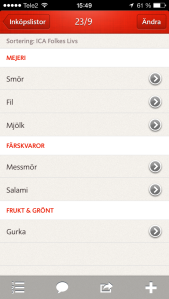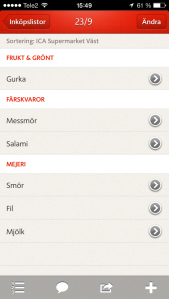As days pass by we are all getting older. With science and medicine it looks like the average duration of life is getting higher and higher. That is why we need to think about how we want to live and why it is good to design for the elderly. As the personal help for elderly is getting worse because of the costs it is good to design a home that makes it easier to live on your own.
I have two grand mothers, one who live in a home for elderly with personal help and one who lives at home by her self. There are big differences in these places, and I have thought about what is good and bad about them and tried to design my own home.

I will write about every room in a flat for elderly, but something that goes for all of the rooms is that there are big doors and windows and a lot of space to move around if you are in a wheelchair or use a walker. The flat is not separated in rooms, but are just one big room with different areas. Only the bathroom is a different room. The room is on the same level everywhere and to be able to leave the flat there is a big elevator outside the room that is easy to get in and out of. To access the flat no key is required to remove the struggle of fitting the key inside the keyhole. Instead, it is just a chip that needs to be placed onto a surface and the door opens.
The light switches today are to small so these would be replaced with big buttons that are placed strategically around the flat. One by the bed that controls the light for the whole flat so you do not have to get out of bed if you have forgotten to turn the light off.
A schedule should be connected to the flat that reminds the user of dates and times. With a big screen and big text that says what is next on the schedule. Things like meeting friends and family as well as time for dinner or medicine.
The hall
This part of the room is where you enter. There is a place where you can put you shoes and your jacket. To get the shoes off easily there is a spot where you put one of your feet and the shoe gets sucked onto the device and the foot can easily be lifted off the shoe. There is also space to put the outside walker and switch to an inside walker which has smaller smother wheels.
The kitchen
In the kitchen there is often a lot of stuff high up or down low. This kitchen has the most used stuff in the height of the hip, to minimize the strain on the back. For example, the dishwasher should be easily accessed without having to bend over the reach the dishes. Some older people have problem with memory and that could be dangerous in the kitchen. The stove will have a timer connected that needs to be set to be able to turn it on. In this way there is no worry if the stove is left on. The sink has sensors that turn on the water when moving a hand in front of it. There are a lot of sharp tools in the kitchen, if you don’t have steady hands it is not a good idea to use knives that are heavy, but to hold the knives there is a magnet that keep the knives accessible at the right height. The fridge should be able to sense if the food has gone bad and have recommendations on the front of it.
The TV
It is very common that when you are getting old you spend a lot of time in front of the TV. The TV shows that are the most popular ones are the shows from other countries because they are subtitled. It is hard to hear what they are saying so it is easier just to read. The Swedish shows are not subtitled because they are in Swedish. It is possible to turn on the subtitles, but it is a difficult process for some. In this flat the TV has an easy accessible button on the remote that turns on the subtitles for any TV show. There should also be wireless headphones available because it can be hard to hear what they are saying and you do not want to disturb the whole area.

The bed
The bed is an important part of the flat. It should be able to move up and down and tilt up to support reading in bed. To prevent stigmatization the bed is not suppose to look like a hospital bed, but have the same functionality.
The bathroom
The bathroom is an important, if not the most important, part of the flat. It can be hard sometimes to keep yourself clean and get every part of the body clean when showering. A special chair is placed in the shower so you don’t have to stand up for a long time. This chair have cleaning abilities which help out during the shower process, cleaning the lower part of the body, while the top of the body gets cleaned the regular way.
Conclusion
There are many things to consider when it comes to the elderly and it is easy to make assumptions of what is best for them. It is good to have ideas that can be tried out. To do it right the elderly has to be involved in some way. But there are many elderly people and it is not right to put them in the same category. The flat should be able to customize to every persons need and taste, but the basic could be the same.


